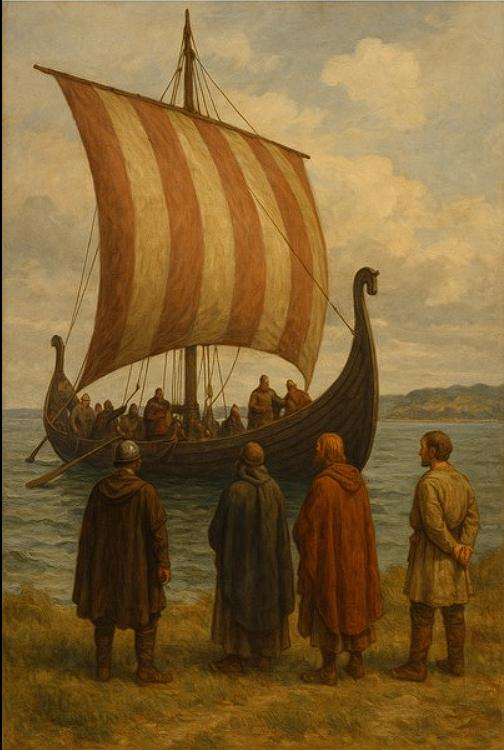When Viking ships first appeared along the coasts of Europe in the 8th century, they brought a wave of change that was met with a spectrum of reactions. These Norse seafarers, known to us as Vikings, were perceived and named differently by the societies they encountered, reflecting their diverse roles as raiders, traders, settlers, and cultural ambassadors. This exploration of their various names reveals a nuanced understanding of their complex impact on the ancient world.
Names of Fear and Familiarity: How Cultures Perceived the Norse
- Dani in England: A Broad Designation:
- In England, the Norse arrivals were broadly referred to as “Dani” (Danes), a term that encompassed all Scandinavians, regardless of their specific origins in Denmark or Norway.
- This simplified designation highlights the initial lack of differentiation among the Norse groups, reflecting the fear and uncertainty they inspired.
- The term “Dani” became synonymous with the Norse presence, shaping the early English perception of these newcomers.
- Dubgaill and Finngaill in Ireland: Distinguishing the Norse:
- The Irish distinguished between “dubgaill” (dark foreigners) and “finngaill” (light foreigners), possibly to differentiate them based on origin, language, or even physical appearance.
- This nuanced categorization suggests a deeper understanding of the Norse groups and their varying impacts on Irish society.
- The Irish names, show that the Irish were able to make a distinction between the different groups of Norse.
- Askomanner in German Regions: The Ash Men:
- In German-speaking regions, the Norse were known as “askomanner” (ash men), likely inspired by their ships, which were often crafted from ash wood.
- This name, born from a simple observation, carries a poetic resonance, highlighting the maritime prowess of the Norse.
- The name, gives us insight into what the Germanic people first noticed about the Norse.
Names of Mystery and Acceptance: Vikings Across Continents
- Al-Majus in Muslim Spain: Enigmatic Outsiders:
- In Muslim Spain, the Norse were called “al-Majus,” a term that could mean anything from “pagans” to “mysterious outsiders,” reflecting the limited understanding of their beliefs and origins.
- This designation underscores the cultural distance and the sense of otherness that the Norse represented in the Iberian Peninsula.
- The name shows the difference in religion, and culture, between the Norse, and the people of Muslim Spain.
- Várangoi in Byzantium: Elite Warriors:
- In Byzantium, the Norse were welcomed as elite warriors, forming the emperor’s famed Varangian Guard, known as “várangoi.”
- This name reflects the high regard in which the Norse were held as skilled fighters and loyal protectors.
- Many Scandinavians traveled to Byzantium willingly, drawn by the promise of wealth, adventure, and honor.
- Normanni in France: Men from the North:
- In France, the Norse were known as “Normanni” (men from the North), a name that would later shape European history through the rise of Normandy and its formidable rulers.
- This designation highlights the Norse impact on the region and their eventual integration into French society.
- The name, is still used today, and shows the lasting impact of the Norse on the region.
The Enduring Legacy of the Vikings: Beyond a Monolithic Image
- Diverse Roles: Raiders, Traders, Settlers:
- These diverse names remind us that the Vikings were not a monolithic force but a complex and multifaceted people, engaging in raiding, trading, and settling.
- Their interactions with different cultures varied significantly, leading to a range of perceptions and designations.
- This complexity makes the Vikings, a very interesting culture to study.
- Cultural Impact: Language, Customs, and Power:
- Whether feared or embraced, the Vikings left an undeniable mark on the world they encountered, influencing language, customs, and political structures.
- Their legacy extends beyond their military exploits, encompassing their contributions to trade, exploration, and cultural exchange.
- Their cultural impact, is still felt today, in many parts of the world.
- A Lasting Fascination: Unraveling the Norse Mysteries:
- The Vikings continue to fascinate and intrigue, their history a blend of myth and reality that invites further exploration.
- Their diverse names and perceptions offer a window into the complex interactions between different cultures in the early medieval period.
- The Vikings, will continue to be a source of study, and fascination, for many years to come.
The varied names given to the Vikings across different cultures reveal a complex and nuanced understanding of their impact on the ancient world. From feared raiders to elite warriors and influential settlers, the Vikings left an indelible mark on history, their legacy still resonating today.
